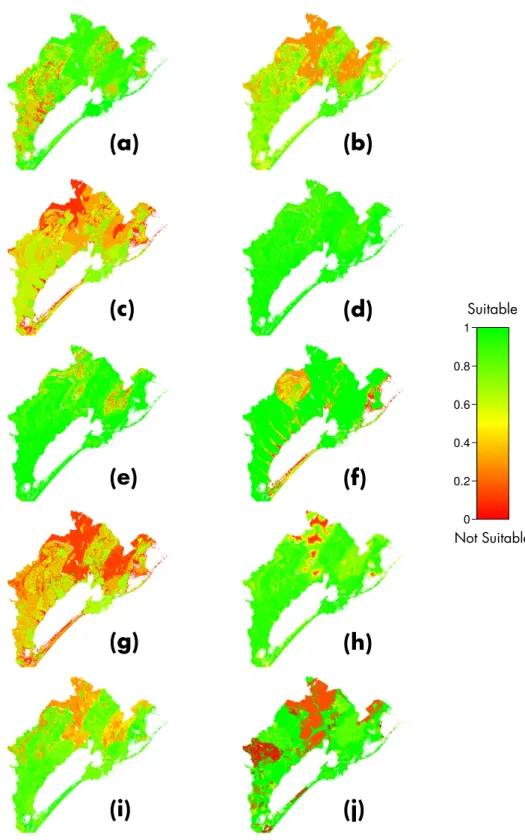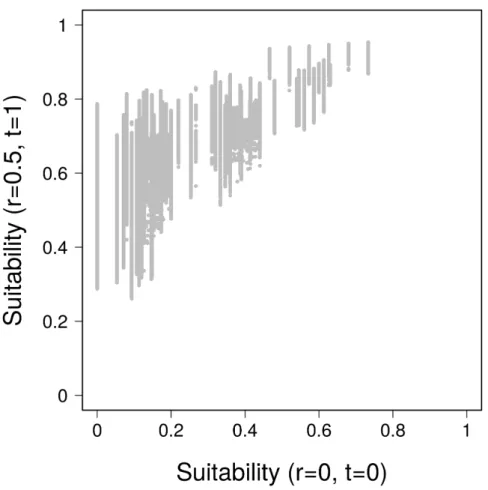HAL Id: hal-02889617
https://hal.inrae.fr/hal-02889617
Submitted on 4 Jul 2020
HAL is a multi-disciplinary open access
archive for the deposit and dissemination of
sci-entific research documents, whether they are
pub-lished or not. The documents may come from
teaching and research institutions in France or
abroad, or from public or private research centers.
L’archive ouverte pluridisciplinaire HAL, est
destinée au dépôt et à la diffusion de documents
scientifiques de niveau recherche, publiés ou non,
émanant des établissements d’enseignement et de
recherche français ou étrangers, des laboratoires
publics ou privés.
efficient territorial planning strategies
Olivier Billaud, Maxence Soubeyrand, Sandra Luque, Maxime Lenormand
To cite this version:
Olivier Billaud, Maxence Soubeyrand, Sandra Luque, Maxime Lenormand. Comprehensive
decision-strategy space exploration for efficient territorial planning strategies.
Computers, Environment
and Urban Systems, Elsevier, 2020, 83, pp.101516. �10.1016/j.compenvurbsys.2020.101516�.
�hal-02889617�
Olivier Billaud,1,∗ Maxence Soubeyrand,1,∗ Sandra Luque,1 and Maxime Lenormand1,†
1
TETIS, Univ Montpellier, AgroParisTech, Cirad, CNRS, INRAE, Montpellier, France GIS-based Multi-Criteria Decision Analysis is a well-known decision support tool that can be used in a wide variety of contexts. It is particularly useful for territorial planning in situations where several actors with different, and sometimes contradictory, point of views have to take a decision regarding land use development. While the impact of the weights used to represent the relative importance of criteria has been widely studied in the recent literature, the impact of the order weights used to combine the criteria have rarely been investigated. This paper presents a spatial sensitivity analysis to assess the impact of order weights determination in GIS-based Multi-Criteria Analysis by Ordered Weighted Averaging. We propose a methodology based on an efficient exploration of the decision-strategy space defined by the level of risk and trade-off in the decision process. We illustrate our approach with a land use planning process in the South of France. The objective is to find suitable areas for urban development while preserving green areas and their associated ecosystem services. The ecosystem service approach has indeed the potential to widen the scope of traditional landscape-ecological planning by including ecosystem-based benefits, including social and economic benefits, green infrastructures and biophysical parameters in urban and territorial planning. We show that in this particular case the decision-strategy space can be divided into four clusters. Each of them is associated with a map summarizing the average spatial suitability distribution used to identify potential areas for urban development. We also demonstrate the pertinence of a spatial variance within-cluster analysis to disentangle the relationship between risk and trade-off values. At the end, we perform a site suitability ranking analysis to assess the relationship between the four detected clusters.
INTRODUCTION
According to the World Health Organization, the fraction of population living in urban area has no-tably increased from the 35% registered back in the 60’s to the 55% estimated in 2018; by 2050, 66% of the worlds population is projected to be urban [1]. Inten-sive urban growth puts pressure on the resources and on the capacity of planners and local authorities to improve the standard of living of the residents. Sus-tainable development relies therefore on the successful management of urban sprawl and the development of efficient territorial planning strategies.
This involves notably to identify the most suitable sites for locating future land uses based on explicit and/or implicit spatial information [2]. The basic idea of site selection is to rank alternative sites based on their characteristics to identify the most suitable site for a specific land use [3]. More specifically, GIS-based land-use suitability analysis consists in combin-ing maps representcombin-ing different suitability criteria to produce a suitability map showing the relative suit-ability of each site for a specific land use [4]. GIS-based land-use suitability analysis has been applied in a wide variety of contexts, including but not lim-ited to urban development. Examples of applications include the identification of animal habitats [5], map-ping of wilderness [6], ecosystem services assessment [7], disease susceptibility mapping [8, 9], soil fertility evaluation [10] and urban planning [11], to name a few.
∗Contributed equally to this work.
†Corresponding author maxime.lenormand@inrae.fr.
Land use suitability analysis methods have evolved considerably since McHarg’s seminal work in 1969 based on hand-drawn overlay techniques [12]. One of the more common GIS-based techniques used to assess land use suitability is the GIS-based Multi-Criteria Decision Analysis method (GIS-MCDA) [13]. GIS-MCDA can be seen as “a process that transforms and combines geographical data and value judgments [...] to obtain appropriate and useful information for de-cision making” [9,14]. It involves three main compo-nents: the geographical information standardization, the criterion weighting and the combination rules [13]. The first component consists in standardizing the dif-ferent geographical layers representing the criterion in comparable units and formats. The second com-ponent involves the weighting of criteria according to their importance. This weighting procedure is usu-ally based on expert knowledge and depends on the structure of the problem. The most popular weighting methods are based on the concept of pairwise compari-son matrix proposed by Saaty as part of Analytic Hier-archy/Network Process [15, 16]. The last component focuses on the combination of the different criteria and their associated weights. This combination essentially relies on additive weighting models. Of particular in-terests is the Ordered Weighted Averaging (OWA) op-erator [17]. OWA introduces a second type of weights in the additive model (called order weights) that al-lows for the “modeling” of decision-maker’s attitude in the decision through the fundamental concepts of risk, trade-off and decision-strategy space [18].
As it is the case in any modeling framework, GIS-MCDA’s outputs are subject to uncertainty gener-ated at different levels of the process. Indeed, it exists several sources of uncertainty regarding
MCDA’s model, inputs and parameters that might impact the final suitability map on which the deci-sion will be based. If we consider GIS-MCDA us-ing OWA operator, four main sources of uncertainty can be identified in the aggregation process: the data used to build the criteria, the method used to gener-ate the geographical layers (scale, standardization...), the methods used to determine the criteria weights and the order weights. While uncertainty of criteria weights has been already investigated in the recent literature [9, 19], the sensitivity of GIS-MCDA out-puts to order weight selection is a topic that is often neglected. The rigorous selection of order weight in GIS-MCDA is of major importance for discussing the outputs with policy makers [6]. However, most of the studies focus on a few typical sets of order weights without developing clear method to efficiently explore the two-dimensional decision-strategy space.
In this work, we tackle this problem by proposing an approach built around a method that allows for an automatic generation of order weights according to a given level of risk and trade-offs [20]. The main advantage of this method lies in the formalization of the relationship between risk (likelihood that the deci-sion made for a given location is wrong) and trade-off (degree of compensation between criteria) providing a clear definition of decision-strategy space. Thus, a full exploration of the decision-strategy space becomes possible, fulfilling a major gap regarding the sensitiv-ity of GIS-MCDA to order weights selection. With an experimental design defined properly followed by a clustering analysis, the decision-strategy space can be segmented into several clusters of order weights leading to the production of similar suitability maps. The resulting clusters are further analyzed to extract an average suitability maps summarizing the infor-mation contains in each cluster. We can then perform a spatial variance within-cluster analysis to measure the degree of uncertainty associated with the average suitability maps. We finally investigate the relation-ship between clusters by performing a site suitability ranking analysis. In what follows, we will describe in detail the methodology before presenting the results highlighting the importance of order weights selection in practical applications.
We illustrate, here, our approach through an ecosys-tem services (ES) valuation for an urban development perspective in South of France, particularly concerned by the growing demands for urbanization. Allowing to evaluate a high diversity of benefits and impacts, the concept of ES has gained importance for urban and coastal planning [21, 22] and successfully combined with an GIS-MCDA framework [7] to undertake ur-ban governance and related policies. Particularly, a promising use of ES as a decision-tool seems to reveal and anticipate trade-offs between the different ES and urbanization [7]. This is why we selected this con-crete application to demonstrate the capacity of our approach for identifying potential spatial decisions re-garding urban development in the light of different ES trade-offs.
The study area and the data are first introduced in the next section. We then describe in detail the methodology before presenting the results highlight-ing the importance of order weights selection in prac-tical applications. The results and the potential lim-itations of our approach are finally discussed in the last section.
STUDY AREA, DATA AND CRITERIA The territory of Thau, situated on the French Mediterranean Coast about 20km West of Montpel-lier, is an important populated area of 60,000 ha and 117,000 inhabitants. With a central lagoon of 7500 ha and 35 km of coastlines, it is a land dominated by water. The territory is remarkably rich in terms of biodiversity, natural areas and landscapes, from the coastal and agricultural plains to the wetlands, the wooden reliefs and the garrigue. The region is highly attractive and subject to a heavy demographic pres-sure. To conciliate urban development, traditional economic activities such as wine production or shell-fish farming and protection of the ecosystems is the main challenge of the territory. To do so, several in-struments of water management and territorial plan-ning exist and an engineering structure, the SMBT (Thau Bassin Joint Association, Syndicat Mixte du Bassin de Thau in French), has been established. This contributed to build up a shared political vision and a common governance over the whole territory [23]. Our main challenge to support territorial planning needs in the region was to evaluate land suitability in order to identify the most suitable areas for spatial urban development. In agreement with the SMBT, which was our main partner for interacting with local stake-holders, we favored an approach based on the assess-ment of ecosystem services (ES) for prioritization of suitable areas susceptible of artificialization by urban development.
We evaluated a high number of ecosystem services based on local expert knowledge. We followed the methodological framework of the capacity matrix, de-veloped by [24] and improved by [25] and [26], which aims at assessing different land use and land cover (LU/LC) types capacities to provide ecosystem ser-vices. In practice, we applied the methodological framework presented by [27], using available LU/LC data (Figure 1) and related biogeophysical informa-tion (see the Appendix for more details). In close collaboration with the SMBT, we determined a set of both, relevant services based on the Common In-ternational Classification of Ecosystem Services [28] and LU/LC types drawn on an accurate land cover map over the territory [29]. Here we leverage exper-tise from a participatory workshop with local experts and contacted individuals supported by the SMBT to complete the matrix [26]. In order to assess the ac-tual supply of ES for the study region, we applied the matrix method, as aforementioned, a qualitative val-uation approach that links spatially explicit LU/LC
Figure 1. Land use map of Thau. The inset shows the location of the studied areas (red circle) on a map of France.
types to a defined set of ES. Each expert proposes a score to assess the capacity of each LU/LC type (Figure 1) to provide to each ES a value of impor-tance. The capacity matrix method reduces the com-plexity of human-environmental systems, allowing re-producibility. It has proven useful in addressing the urgency-uncertainty dilemma for ES assessments, i.e., to provide best available knowledge where detailed modeling is not feasible or where data gaps obstruct more explicit approaches [25].
Nine ES were considered at the end, on the bases of the importance provided by the local experts and stakeholders from the Thau region. These ES are listed in Table 1. Two provisioning services focus on food from crop production and gathering. The four regulating services are related to main territo-rial challenges in terms of conservation of natural habitats for biodiversity (i.e. nesting sites, breeding grounds,...), including maintaining a good biochemi-cal water status, protection against erosion and flood-ing. Cultural services also ranked high, reflecting the importance that people provide to the benefits from the surrounding nature, through contemplating beau-tiful landscape or open air activities. Finally, risks were also considered, in particular, the risk of wildfires that is pondered a main disservice of Mediterranean ecosystems.
Each ES were spatialized using the high resolution (5×5m2) LU/LC map (Figure1) and the average score
given to the different LU/LC types by the experts. In order to refine the services assessment that is essen-tially based on the LU/LC type, we added external biophysical data to adjust the evaluation. We added for instance information about soil quality to the cul-tivated crops ES or a fire hazard index using physical informations (slope, exposure, wind, etc) to the disser-vice of wildfires. More details about this process are available in the Appendix. Note that we also added a tenth layer to measure the importance of habitat patches for landscape connectivity [30] using the GUI-DOS software [31].
It is worth noting that the ten standardized geo-graphical layers described above have been normalized to obtain a suitability for urban development inversely proportional to the score given by the expert. At the end of the process, for a given criteria, the pixel value are ranging from 0 when it is unsuitable for urban land use to 1 in the opposite case. All the criterion maps are available in Figure S1. All the information was stored in a matrix Z which value zij represents
the suitability of pixel i for urban land use according to criteria j.
Finally, the relative importance of each criteria (i.e. criterion weights) is the number of experts that
con-Criterion Type of service Biophysical data Criterion weight
Cultivated crops Provisioning Soil quality 0.53
Wild plants, algae, fungi and their outputs Provisioning - 0.33
Maintaining nursery populations and habitats Regulating ZNIEFF I and Natura 2000 areas 1
Maintenance of water quality Regulating Flow accumulation 0.93
Mass stabilization and control of erosion Regulating Slope Length Factor 0.40
Flood Protection Regulating Flooding hazard 0.53
Aesthetic Cultural - 0.33
Physical and experiential interactions Cultural Accessibility : distance to the main roads 0.53
Wildfires Disservice Fire hazard 0.40
Habitat patches importance - - 1
Table 1. List of criteria and their associated criterion weight.
sidered the ES important for the territory of Thau divided by the total number of experts (Table1). An exception for the last criterion (the connectivity) that has been set to one after discussion with experts of the SMBT.
DECISION-STRATEGY SPACE’S EXPLORATION
This section describes the methods used to effi-ciently explore the decision-strategy space in GIS-MCDA using OWA operators. This methodology is summarized in Figure2.
OWA operator
In this work, we rely on an Ordered Weighted Aver-aging (OWA) multi-criteria operator [17] to combine all the criteria together in order to obtain a spatial explicit representation, that was a final map, to allow decision makers and local expertes to base planning decisions. OWA operators can indeed be used in a GIS context [18] in which every pixel is considered in-dependently and defined by a set of criteria values. Two types of weights can be considered while using OWA operators: the criterion weights representing the relative importance of the criteria in the decision process, and the order weights characterizing the level of risk and trade-off taken in the decision. Criterion weights are represented by a vector V = (vj)1≤j≤n,
where n stands for the number of criteria (n= 10 in our case). The jthcriterion weight corresponds to the
relative importance given to the jth criteria. In this
particular application, the criterion weights are given by a panel of experts (Table1) and reflects the impor-tance of the criteria regarding urban land use. Order weights are represented by a vector W = (wj)1≤j≤n.
These weights are applied to the ranked criteria on a pixel basis. For a given pixel, the first order weight w1 is assigned to the criterion with the lowest value,
the second order weight w2 to the second lowest
cri-terion... While criterion weights are usually based on expert knowledge, order weights are used to adjust
the level of risk and trade-off in the aggregation pro-cess. Note that in both cases, the vectors of weights sums to 1,∑nj=1vj= ∑nj=1wj= 1. Formally, the OWA
operator is applied to every pixel i with the following formula. OW Ai= n ∑ j=1( v(j)wj ∑n k=1v(k)wk) zi(j) (1)
where zi(j)is the jthlowest element of the collection
of criteria zijfor the pixel i and v(j)is the jthcriterion
weight reordered accordingly.
Risk and trade-off
As mentioned above, order weights are deeply linked with the concepts of risk and trade-off in the decision-strategy process. Different order weights combinations (w1, ..., wn) ∈ [0, 1]n lead to different
levels of risk and trade-off values, and we will see later that the reciprocal is not so clear.
For a given pixel i, a combination of order weights that favors low zij values, W = (1, 0, ..., 0) for
exam-ple, represents a risk-aversion position. On the con-trary, a combination of order weights that gives full weight to high zijvalues, W = (0, 0, ..., 1) for example,
represents a more risk-taking attitude. In the latter situation the risk is to give a high suitability to a pixel only based on the criteria with the highest suitability without taking into account the information given by the other criteria. As the name suggests, the trade-off represents the degree of accommodation between cri-teria. It can be seen as a measure of dispersion over the order weights. The maximum level of trade-off is reached when wj= 1/n for all criteria and a minimum
(W = (1, 0, ..., 0)) and maximum (W = (0, 0, ..., 1)) risk implies an absence of trade-off. Therefore, risk and trade-off are not independent and they are completely determined by the order weights distribution, the risk by its skewness and the trade-off by its dispersion [18]. The relationship between order weights, risk and trade-off forms a decision-strategy space usually rep-resented by a triangle to highlight the inconsistency of certain couple of risk and trade-off values. If we
0.0 0.2 0.4 0.6 0.8 1.0 0.0 0.2 0.4 0.6 0.8 1.0 Risk Tr ade −off
Criteria 1 Criteria 2 Criteria n
OWA
c) Build a suitability map for each vector W generated with the ED
w
1...
b) Experimental Design (ED)
d) Dissimilarity matrix
e) Cluster analysis
w
2w
na) Selection and weighting of criteria
...
v
1Expert panel
v
2v
nW = (w , ... , w )
1 nFigure 2. Methodology developed to efficiently explore the decision-strategy space. a) Selection and weighting of criteria with an expert panel. b) Design an experimental plan to automatically generate order weights according to a set of risk and trade-off values. c) Build a suitability map for each vector of order weights generated with the experimental design. d) Build the dissimilarity matrix based on the euclidean distance between suitability map. e) Perform a cluster analysis to identify homogeneous area of the decision-strategy space.
express the level of risk and trade-off as a couple of values(r, t) ∈ [0, 1]2, the three vertices of the triangle
are represented by the three main configurations: low risk with no trade-off (r = 0, t = 0), high risk with no trade-off (r = 1, t = 0) and medium risk with full trade-off(r = 0.5, t = 1).
Experimental design and cluster analysis Except for some trivial cases, like the ones described above, the limits of the decision-strategy space remain unclear, making an efficient exploration very compli-cated. This is due to the fact that, in practice, the
generation of order weights according to a certain level of risk and trade-off is not formally established. [20] recently proposed a methodology to generate order weights using truncated distributions. The method allows for an automatic generation of order weights according to a certain level of risk and trade-off based on the two first moments of the order weights distribu-tion. More specifically, each suitable couple of(r, t) values is associated with a truncated normal distri-bution with an average r and a standard deviation proportional to t. The probability density function is then discretized to obtain n order weights reflecting the predetermined level of risk r and trade-off t. It is important to note that for certain risk and trade-off
0 0.2 0.4 0.6 0.8 1 Suitable Not Suitable
Intermediate risk with full trade-off
Low risk with no trade-off High risk with no trade-off
0.0 0.2 0.4 0.6 0.8 1.0 0.0 0.2 0.4 0.6 0.8 1.0 Risk Trade-off
Decision-strategy space
Figure 3. Decision-strategy space and suitability maps obtained with typical sets of order weights.
values, no suitable truncated normal distribution can be found. This allows for a formal delimitation of the decision-strategy space, which takes, in this case, the form of a parabola whose equation is y = 4x(1 − x) (Figure2). See [20] for more details.
In this work, we draw upon these recent advances in order weights determination to conduct a sensitivity analysis to assess the impact of the level of risk and trade-off in GIS-MCDA. The guiding idea is to effi-ciently explore the decision-strategy space in order to
identify clusters of risk and trade-off values that leads to similar final suitability maps. As illustrated in Fig-ure 2, we develop on a five steps approach to reach this goal. As it is usually the case in GIS-MCDA, we start with the selection and weighting of criteria with a panel of experts selected for their knowledge and heterogeneous point of view regarding the prob-lem (urban land use allocation in our case). We then design an experimental plan to automatically gener-ate an order weight vector W covering the
decision-strategy space. In this study, we generate 1, 000 vec-tors of order weights associated with 1, 000 risk and trade-off values. A suitability map is built for each vector of order weights using the OWA operator in-troduced in Equation 1. Then, the suitability maps are compared by measuring the euclidean distance be-tween pixel values for each pair of suitability maps. We finally obtain a dissimilarity matrix used to per-form a clustering analysis and identify clusters of risk and trade-off values. An average suitability map and its associated standard deviation is finally computed for each cluster.
Site suitability ranking analysis
In order to compare the ranking of sites (i.e. 5× 5m2 pixels) in two different clusters, we rely on the Kendall’s τ coefficient [32]. A value close to 1 means that the sites are ordered in the same way according to their suitability in both clusters, while a value close to 0 means that there is no concordance in the clus-ter suitability rankings. It is also possible to evalu-ate the similarity between rankings by computing the percentage of sites in common in the top sites of the two rankings. The evolution of this quantity with the number of considered top sites will inform us on the relationship between the different detected clusters.
RESULTS
Minimal decision-strategy space’s exploration In order to get a better grasp of the situation we plot in Figure 3 suitability maps obtained with typ-ical vectors of order weights. We observe that the low risk attitude (W = (1, 0, ..., 0)) is very conserva-tive and identify very few suitable areas (most of the pixel show a suitability lower than 0.5). The area identified as not suitable are mostly composed of nat-ural vegetation. Nevertheless, this extreme position toward risk attitude allows for the identification of ar-eas that are suitable to urban development whatever the considered criterion. There are indeed several pix-els with a high suitable score (higher than 0.5) that are mainly close to built-up area. Conversely, an extreme risk taking attitude (W = (0, 0, ..., 1)) tend to make the whole studied area suitable to urban development. This is due to the fact that for a given pixel one can always find a criterion suitable to urban development. These two configurations are not very nuanced since, on a pixel basis, the information is only coming from one criteria. Results obtained with the weighted linear combination that corresponds to an intermediate risk with full trade-off (top of the triangle) take better ac-count of the heterogeneity of criteria. Note that in this particular configuration, the order weights have no im-pact on the process. We observe, then, that this full trade-off configuration leads globally to similar spatial
features than the ones obtained in the low risk case, but with a level of suitability that is globally higher. However, beyond visual similarities between relative spatial suitability distributions, it is worth noting that the relative suitability of certain areas as compared with others is not the same in the two cases. Indeed, pixels with the same level of suitability in the low risk attitude case can have very different levels of suitabil-ity in the full trade-off configuration (see Figure S2 in Appendix for more details).
Comprehensive decision-strategy space’s exploration
This first result provides informative evidence on the importance of comparing the impact of risk and trade-off values on suitability maps in GIS-MCDA. This is why it is crucial to efficiently explore the decision-strategy space for a more accurate interpreta-tion of the results obtained in GIS-MCDA. Following the method described in the previous section, we build a dissimilarity matrix between 1, 000 suitability maps associated with 1, 000 couple of risk and trade-off val-ues drawn at random within the parabolic decision-strategy space. In order to identify potential cluster of risk and trade-off values leading to similar suitabil-ity maps, we apply an ascending hierarchical cluster-ing (AHC) algorithm on this dissimilarity matrix us-ing the Ward’s agglomeration method. We choose the number of cluster based on the evolution of the ratio between the within-group variance and the total vari-ance as a function of the number of clusters (Figure
4). 5 10 15 20 0.0 0.2 0.4 0.6 0.8 1.0 Number of clusters Within / total v ar iance
Figure 4. Ratio between the within-group variance and the total variance as a function of the number of clusters. We detect four clusters or groups of risk and trade-offs values that share similarities in the suitability maps that they produced. We then compute the av-erage suitability maps associated with each of the selected clusters. The results are shown in Figure
5. We first observe that the segmentation of the parabolic decision-strategy space is mainly driven by the level of risk. Although there is a difference in trend
0.0 0.2 0.4 0.6 0.8 1.0 0.0 0.2 0.4 0.6 0.8 1.0 Risk Trade-off 0 0.2 0.4 0.6 0.8 1 Suitable Not Suitable
Cluster 1
Cluster 4
Cluster 2
Cluster 3
Figure 5. Average suitability maps associated with the four clusters.
across pixels, the global level of suitability increases monotonously with the risk. The segmentation ob-tained with high levels of hierarchical aggregation flects therefore the global structure induced by the re-ordering of criteria. However, it must be noticed that when considering a higher number of clusters a trade-off based segmentation highlights differences among pixels for a given global level of suitability (see Fig-ure S3 in Appendix for more details). The average
suitability maps associated with the four clusters en-able us to have a more nuanced view of the situation in the Thau region that with the typical sets of or-der weights (Figure3). The low risk cluster provided a very conservative situation but bring into light the most suitable areas (the only ones with a correct suit-ability) that have a potential to be urbanized first within a sustainable planning framework. The low-medium risk cluster releases a large proportion of the
0.0 0.2 0.4 0.6 0.8 1.0 0.0 0.2 0.4 0.6 0.8 1.0 Risk Trade-off 0 0.05 0.1 0.15 0.2 0.25 Standard deviation
Cluster 1
Cluster 4
Cluster 2
Cluster 3
Figure 6. Spatial distribution of the within-cluster variability.
agricultural land-use that is still suitable for urbaniza-tion. Conversely it allowed to identify the most impor-tant agricultural areas. The map of the medium-high risk cluster identifies almost all the agricultural areas suitable for urbanization. Ecosystems that provide a maximum of ES such as forests, garrigues or salt-meadows are the only areas that are considered not suitable using the approach presented. Eventually, the high risk cluster provided a map quite similar to
the extreme risk situation, but allows to detect some critical ecosystems (mostly forests) of major impor-tance in the region.
Although the total within-group variance obtained with four clusters is relatively low (Figure4), it is also important to evaluate how this variability is spatially distributed. Notably, this variance based analysis will allow us to assess the impact of the trade-off for a given level of risk. We observe in Figure 6 that the
spatial distribution of standard deviation of the suit-ability varies from one cluster to another. The un-certainty seems to be correlated with the suitability. However, the nature of the relationship changes ac-cording to the type of cluster. The uncertainty tends to increase with the suitability for the low and medium risk cluster, while the opposite behavior is observed for the high risk cluster.
Site suitability ranking analysis
Table2shows the Kendall’s τ coefficient matrix [32] between the site suitability rankings obtained with the different clusters (Figure 5). We observe that the co-efficient are globally high with values ranging from 0.6 and 0.85. We find in particular that τ decreases as the distance between clusters increases.
Table 2. Kendall rank correlation matrix. Kendall’s τ co-efficient between the four suitability maps displayed in Figure
5. Scatterplots of the suitability values obtained with the different clusters are available in Figure S4 in Appendix.
Cluster 1 Cluster 2 Cluster 3 Cluster 4
Cluster 1 1 0.84 0.72 0.61
Cluster 2 1 0.85 0.71
Cluster 3 1 0.82
A similar pattern can be observed in Figure7. The percentage of sites in common in the top sites of two rankings tends to decrease with the distance between clusters. In most cases, the similarity between clusters increases with the number of sites considered in the top sites. Clusters 2 and 3 are very similar in terms of rankings with more than 80% of sites in common whatever the top sites considered. The similarity be-tween the cluster 1 and clusters 2 and 3 shows a dif-ferent pattern with a strong similarity of sites in the top 0.01% followed by a rapid decay and then an in-crease as observed in the general trend. This implies that clusters 1, 2 and 3 share a core of high suitabil-ity sites. Although, cluster 4 does not share this core of high suitability sites, it is interesting to note that, considering the top 0.03% and higher, it shares more sites with cluster 2 and 3 than cluster 1 does.
DISCUSSION
In this paper, we presented an approach to as-sess the impact of order weights and their associ-ated level of risk and trade-off in GIS-based Multi-Criteria Decision Analysis. The developed approach aims at efficiently explore the decision-strategy space formed by the relationship between risk and trade-off in Ordered Weighted Averaging. Although the results might vary according to the formula used, a vector of
0.02 0.04 0.06 0.08 0.10 0 20 40 60 80 100
Percentage of sites contained in the top sites
P
ercentage of sites in common
Clusters 1−2 Clusters 1−3 Clusters 1−4 Clusters 2−3 Clusters 2−4 Clusters 3−4
Figure 7. Pairwise cluster ranking comparisons. For each pair of clusters the percentage of sites in common in the top suitable sites is computed. For example, there is about 80% of sites (i.e. pixels) in common in the top 0.01% of suitable sites obtained with the clusters 1 and 3 (first red triangle).
order weights in OWA, whatever its size, can be sum-marized by its level of risk and trade-off. However, the opposite is not always true, making it complicated to automatically generate order weights according to a certain level of risk and trade-off and conduct rigor-ous sensitivity analysis. In this paper, we relied on the recent advances made in order weight determination proposed in [20]. The method presented in this paper proposes to automatically generate order weights us-ing truncated distributions accordus-ing to a certain level of risk and trade-off based on the two first moments of the order weights distribution. This methodological framework enabled us to generate a suitability map for each couple of suitable risk and trade-off values through an OWA operator, opening the possibility to perform systematic sensitivity and uncertainty anal-ysis in GIS-MCDA. It is indeed important to model the decision makers’ attitudes toward risk in MCDA [13, 33]. The comprehensive exploration of the two-dimensional decision-strategy space proposed in this paper provides a generic and rigorous way to model, aggregate and compare a full range of scenarios. This is an important topic in MCDA that should not be neglected. Especially since it it can be easily com-bined with existing method used to compute the cri-teria weights [34–37].
We illustrated the potential of our approach on a case study of land use management in the territory of Thau (France). We selected this example to pro-pose practical solutions to the common problem that is experiencing the south of France regarding urban sprawl, but also for its relevance as a concrete ap-plication of ecosystems’ valuations using GIS-MCDA. The idea here is to prioritize suitable areas for urban development in the Thau territory, while preserving optimally “green” areas and their associated ecosys-tem services to promote a sustainable regional man-agement. Indeed, one of the biggest challenges we are facing nowadays is to find suitable new areas for
development in a sustainable way, without degrading existing valuable land uses. Spatial planning for ur-ban development is directly related to decision-making and government strategies, besides outcomes of plan-ning will clearly differ depending on stakeholders and territorial policies. The ecosystem service approach has the potential to widen the scope of traditional landscape-ecological planning to include ecosystem-based benefits, including social and economic bene-fits, green infrastructures and biophysical parameters to directly strengthen the role of landscape-ecological planning in urban and territorial planning [38, 39]. The results obtained in this study demonstrates that a complete exploration of the decision-strategy space enabled us to get a better understanding of how the different ecosystem services combine to produce the final suitability map. In particular, the clustering analysis led to an informative segmentation of the decision-strategy space that helped us to really under-stand the role of order weights and particularly their impact on the trade-off between criteria. Finally, a site suitability ranking analysis allowed us to examine the differences and similarities between the different clusters.
Our approach has the great advantage to be generic and relatively easy to implement in any multi-criteria evaluations. Although further analysis on more case studies are certainly needed, we believe that the ap-proach developed in this study could provide an op-erational and collaborative tool to facilitate decision making processes to improve land use planning. This is particularly important as the final suitability map obtained in such process might be used to take im-portant and irreversible decisions regarding land use
management. Therefore, it is crucial to provide ro-bust and quality-assessed materials to facilitate the dialogue between stakeholders and decision-makers.
ACKNOWLEDGMENTS
This study was partially supported by the ER-ANET BIODIVERSA 3 funded Project IMAGINE (Integrative Management of Green Infrastructures Multifunctionality, Ecosystem integrity and Ecosys-tem Services: From assessment to regulation in socio-ecological systems) and the French National Research Agency (project NetCost, ANR-17-CE03-0003 grant). A special thanks goes to Pierre Maurel, Julien Le Viol and the members of the SMBT of Thau Region. We acknowledge Marine Le Louarn for providing us with the landscape connectivity map.
DATA AVAILABILITY
Code and data are available at www.
maximelenormand.com/Codes
AUTHOR CONTRIBUTIONS
ML coordinated the study, designed the study and wrote the paper. ML, OB and MS wrote the code, processed and analyzed the data. SL coordinated the study. All authors read, commented and validated the final version of the manuscript.
[1] United Nations, Department of Economic and So-cial Affairs, Population Division. World Population Prospects 2019 Highlights (ST/ESA/SER.A/423), 2019.
[2] M. G. Collins, F. R. Steiner, and M. J. Rushman. Land-Use Suitability Analysis in the United States: Historical Development and Promising Technological Achievements. 28(5):611–621, 2001.
[3] J. Malczewski. GIS-based land-use suitability anal-ysis: A critical overview. Progress in Planning, 62(1):3–65, 2004.
[4] R. E. Klosterman, K. Brooks, J. Drucker, E. Feser, and H. Renski. Planning Support Methods: Urban and Regional Analysis and Projection. Rowman & Littlefield, June 2018.
[5] R. Store and J. Kangas. Integrating spatial multi-criteria evaluation and expert knowledge for GIS-based habitat suitability modelling. Landscape and Urban Planning, 55(2):79–93, 2001.
[6] A. Comber, S. Carver, S. Fritz, R. McMorran, J. Washtell, and P. Fisher. Different methods, dif-ferent wilds: Evaluating alternative mappings of wildness using fuzzy MCE and Dempster-Shafer MCE. Computers, Environment and Urban Systems, 34(2):142–152, 2010.
[7] J. Langemeyer, E. G´omez-Baggethun, D. Haase, S. Scheuer, and T.s Elmqvist. Bridging the gap between ecosystem service assessments and land-use planning through Multi-Criteria Decision Analysis (MCDA). Environmental Science & Policy, 62:45–56, 2016.
[8] S. Dong. Comparisons between different multi-criteria decision analysis techniques for disease susceptibility mapping. Student thesis series INES, 2016.
[9] A. Tran, C. Trevennec, J. Lutwama, J. Sserugga, M. G´ely, C. Pittiglio, J. Pinto, and V. Cheva-lier. Development and Assessment of a Geographic Knowledge-Based Model for Mapping Suitable Areas for Rift Valley Fever Transmission in Eastern Africa. PLOS Neglected Tropical Diseases, 10(9):e0004999, 2016.
[10] M. Mokarram and M. Hojati. Using ordered weight averaging (OWA) aggregation for multi-criteria soil fertility evaluation by GIS (case study: Southeast Iran). Computers and Electronics in Agriculture, 132, 2017.
[11] J. Chen. GIS-based multi-criteria analysis for land use suitability assessment in City of Regina. Environ-mental Systems Research, 3(1):13, 2014.
[12] I. L. McHarg. Design with Nature. John Wiley & Sons, 1969.
[13] J. Malczewski and C. Rinner. Multicriteria Deci-sion Analysis in Geographic Information Science. Ad-vances in Geographic Information Science. Springer-Verlag, Berlin Heidelberg, 2015.
[14] J. Malczewski. GIS-based multicriteria decision anal-ysis: A survey of the literature. International Journal of Geographical Information Science, 20(7):703–726, 2006.
[15] R. W. Saaty. The analytic hierarchy process—what it is and how it is used. Mathematical Modelling, 9(3):161–176, 1987.
[16] T. L. Saaty. The Analytic Network Process. In T. L. Saaty and L. G. Vargas, editors, Decision Making with the Analytic Network Process: Economic, Political, Social and Technological Applications with Benefits, Opportunities, Costs and Risks, International Series in Operations Research & Management Science, pages 1–26. Springer US, 2006.
[17] R. R. Yager. On Ordered Weighted Averaging Ag-gregation Operators in Multicriteria Decision making. IEEE Transactions on Systems, Man, and Cybernet-ics, 18(1):183–190, 1988.
[18] H. Jiang and J. R. Eastman. Application of Fuzzy Measures in Multi-Criteria Evaluation in GIS. Inter-national Journal of Geographical Information Science, 14(2):173–184, 2000.
[19] B. Feizizadeh and S. Kienberger. Spatially explicit sensitivity and uncertainty analysis for multicriteria-based vulnerability assessment. Journal of Environ-mental Planning and Management, 60(11):2013–2035, 2017.
[20] M. Lenormand. Generating OWA weights using trun-cated distributions. International Journal of Intelli-gent Systems, 33(4):791–801, 2018.
[21] E. G´omez-Baggethun and D. N. Barton. Classifying and valuing ecosystem services for urban planning. Ecological Economics, 86(C), 2013.
[22] K. K. Arkema, G. M. Verutes, S. A. Wood, C. Clarke-Samuels, S. Rosado, M.a Canto, A. Rosenthal, M. Ruckelshaus, G. Guannel, J. Toft, J. Faries, J. M. Silver, R. Griffin, and A. D. Guerry. Embedding ecosystem services in coastal planning leads to bet-ter outcomes for people and nature. Proceedings of the National Academy of Sciences, 112(24):7390– 7395, 2015.
[23] P. Maurel, R. Plant, O. Barreteau, and Y. Bertac-chini. Beyond iwrm : developing territorial intelli-gence in the thau territory, france. In Victor Squires, Hugh Milner, and Katherine Daniell, editors, River Basin Management in the Twenty-First Century : People and Place, pages 22–41. CRC Press, 2014. [24] B. Burkhard, F. Kroll, F. M¨uller, and W. Windhorst.
Landscapes’ capacities to provide ecosystem services ? a concept for land-cover based assessments. Landscape Online, 15:1–12, 2009.
[25] S. Jacobs, B. Burkhard, T. Daele, J. Staes, and A. Schneiders. ’the matrix reloaded’: A review of ex-pert knowledge use for mapping ecosystem services. Ecological Modelling, pages 21–30, 2014.
[26] C. S. Campagne, P. Roche, F. Gosselin, L. Tschanz, and T. Tatoni. Expert-based ecosystem services
ca-pacity matrices: Dealing with scoring variability. Eco-logical Indicators, 79:63–72, 2017.
[27] C. S. Campagne and P. Roche. May the matrix be with you! guidelines for the application of expert-based matrix approach for ecosystem services assess-ment and mapping. One Ecosystem, One Ecosystem 3: e24134, 05 2018.
[28] R Haines-Young and M.B Potschin. Common interna-tional classification of ecosystem services (cices) v5.1 and guidance on the application of the revised struc-ture, 2018.
[29] C. Dupaquier, A. Desbrosse, P. Maurel, and J-P Rous-sillon. Cartographie de l’occupation du sol sur le bassin de Thau. Rapport m´ethodologique, 2016. [30] S. Saura and Josep Torn´e. Conefor Sensinonde 2.2:
A software package for quantifying the importance of habita patches for landscape connectivity. Environ-mental Modelling & Software, 24:135–139, 2009. [31] P. Vogt and K. Riitters. GuidosToolbox: universal
digital image object analysis. European Journal of Remote Sensing, 50:352–361, 2017.
[32] L. Puka. Kendall’s Tau, pages 713–715. Springer Berlin Heidelberg, Berlin, Heidelberg, 2011.
[33] S. E. Bodily. Modern Decision Making: A Guide to Modeling With Decision Support Systems. McGraw Hill Higher Education, New York, 1985.
[34] K. A. Eldrandaly. Exploring multi-criteria decision strategies in GIS with linguistic quantifiers: An exten-sion of the analytical network process using ordered weighted averaging operators. International Jour-nal of Geographical Information Science, 27(12):2455– 2482, 2013.
[35] Marzieh Mokarram and Abbas Mirsoleimani. Using Fuzzy-AHP and order weight average (OWA) meth-ods for land suitability determination for citrus culti-vation in ArcGIS (Case study: Fars province, Iran). Physica A: Statistical Mechanics and its Applications, 508:506–518, October 2018.
[36] M. Kazemi-Beydokhti, R. Ali Abbaspour, M. Kherad-mandi, and A. Bozorgi-Amiri. Determination of the physical domain for air quality monitoring stations using the ANP-OWA method in GIS. Environmental Monitoring and Assessment, 191(2):299, 2019. [37] H. Zabihi, Me Alizadeh, Pe Kibet Langat,
Me Karami, He Shahabi, Ae Ahmad, M. Nor Said, and S. Lee. GIS Multi-Criteria Analysis by Ordered Weighted Averaging (OWA): Toward an Inte-grated Citrus Management Strategy. Sustainability, 11(4):1009, 2019.
[38] L. Kopperoinen, P. Itkonen, and J. Niemel¨a. Using ex-pert knowledge in combining green infrastructure and ecosystem services in land use planning: An insight into a new place-based methodology. 29(8):1361– 1375, 2014.
[39] P. Bez´ak, P. Mederly, Z. Izakoviˇcov´a, J. ˇSpulerov´a, and C. Schleyer. Divergence and conflicts in landscape planning across spatial scales in Slovakia: An oppor-tunity for an ecosystem services-based approach? In-ternational Journal of Biodiversity Science, Ecosys-tem Services & Management, 13(2):119–135, 2017.
APPENDIX Biophysical data
As mention in the main text, we added external biophysical data (Table 1) to adjust the ES valuation. For each pixel, the experts scores associated with the ES has been multiply by the factor extracted from the biophysical data as described below.
• The soil quality is an index made by the French National Institute for Agronomic Research and based on two main constraints (salinity and the available water capacity) and secondary constraints (soil sealing, hydromorphy, stoniness and pH). It has 16 categories so we assigned a multiplicative factor 1 to the most fertile and decreased of 0.05 for each category to end at 0.25 for salted ground.
• Habitats of ecological importance are defined areas by naturalists studies such as ZNIEFF I (Natural zone of ecological interest in terms of fauna and flora) or Natura 2000 (EU wide network of nature protection areas). We applied factor 1 when the pixel was located inside these protected area and 0.75 otherwise. • Flow accumulation follow a hydrologic model of Multiple Flow Direction Algorithm. The value are
con-verted to a 0-1 continuous scale. To avoid a crushed scale, we used 98% of the maximal value to set 1. Values above are also set to 1.
• We used a Slope Length Factor used by the Universal Soil Loss Equation (USLE) to adjust the mass stabilization and control of erosion ES. Here also, the value are converted to a 0-1 continuous scale. To avoid a crushed scale, we used 98% of the maximal value to set 1. Values above are also set to 1.
• The flooding hazard came from the official and mandatory risk prevention plans for inundations. It has three categories (high, medium, none) that corresponds respectively to a factor 1, 0.5 or 0.
• Distance to the main road was computed on SAGA GIS, taking into account of the relief. It is a proxy of accessibility, we used the threshold of 300m as the maximum distance for a recreational walk (5 min walk) to defined three categories: ≤ 300m, 300m-1km, ≥ 1km. Since almost the whole territory is suitable for hiking (no high elevation and slopes) we stopped the scale at 0.5 for a distance higher than 1km (around 15min walk) and computed a decreasing and continuous scale from 1 to 0.5 between 300m and 1km. • The fire hazard has been derived from forest stands combustibility and spreading factors such as slope and
speed propagation in a study carried out by the National Forest Office (ONF) and the Sea and Territory Departmental Direction (DDTM). For 6 values (very high, high, medium, low, very low, none) we started at a factor 1 for a very high risk and decreased of 0.1 for each category to end at 0.5 (unlike the flooding hazard, we considered that there was always a fire risk).
Supplementary figures 0 0.2 0.4 0.6 0.8 1 Suitable Not Suitable
(a)
(b)
(c)
(e)
(g)
(i)
(d)
(f)
(h)
(j)
Figure S1. Map of the criteria. The value are comprised between 0 and 1 assessing the suitability of each pixel to urban development inversely proportional to its capacity to provide the ES. (a) Cultivated crops. (b) Wild plants, algae, fungi and their outputs. (c) Maintaining nursery populations and habitats. (d) Maintenance of water quality. (e) Mass stabilization and control of erosion. (f) Flood Protection. (g) Aesthetic. (h) Physical and experiential interactions. (i) Wildfires. (j) Habitat patches importance.
Figure S2. Comparison between suitability values obtained in the low risk with no trade-off configuration (r=0,t=0) and the intermediate risk with full trade-off configuration (r=0.5,t=1). Each grey point represents a pixel.
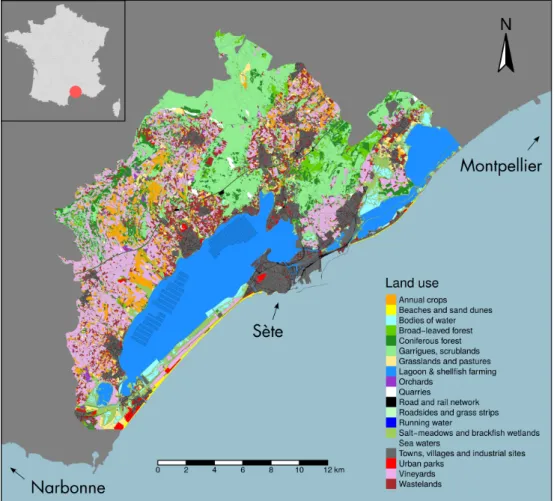

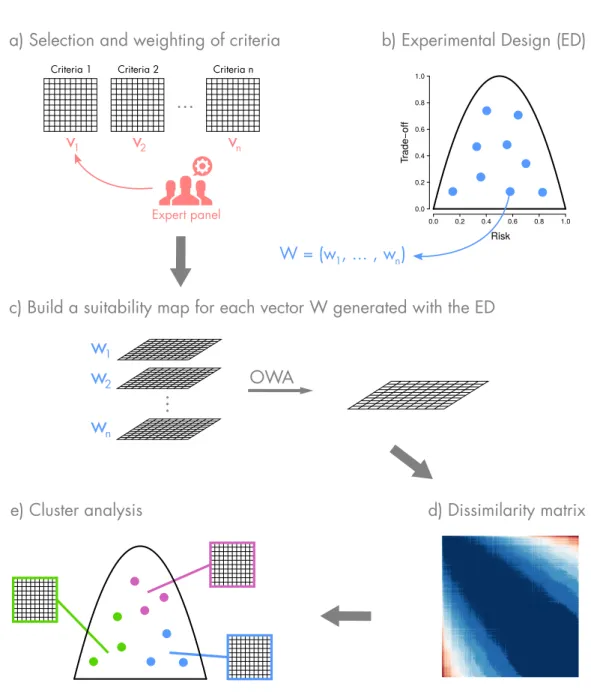
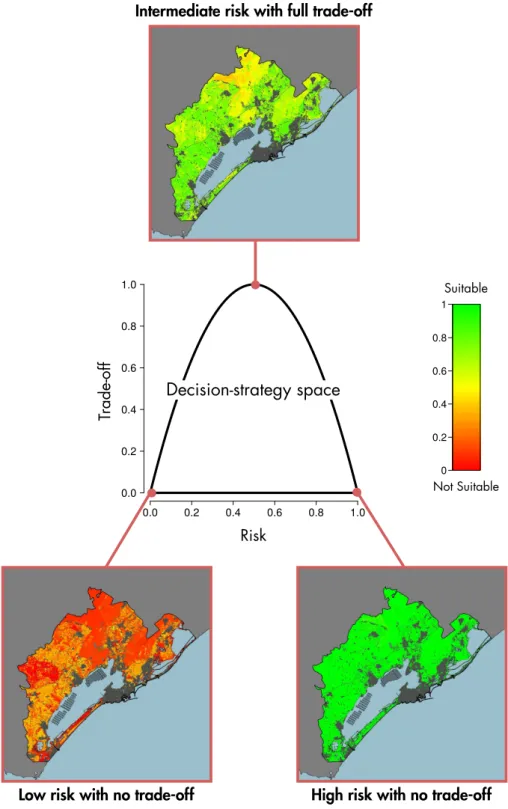
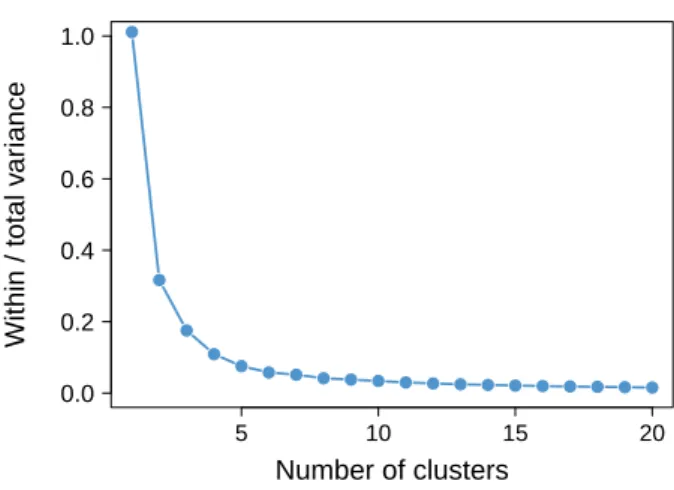
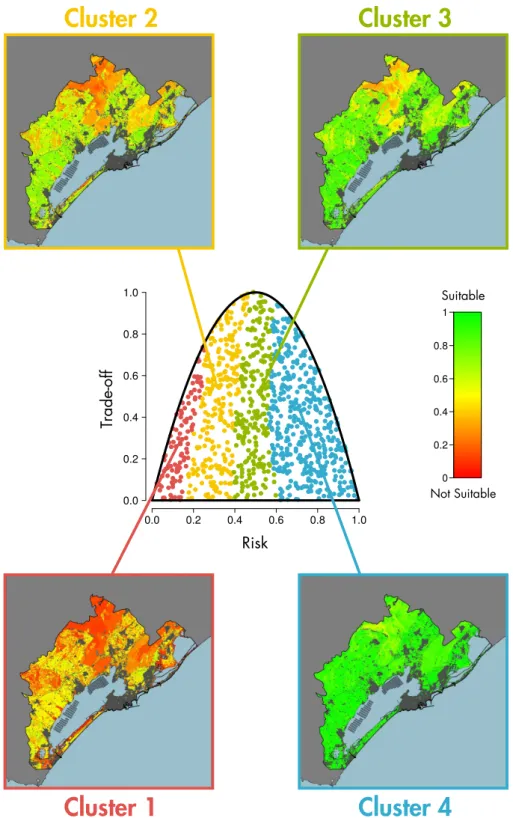
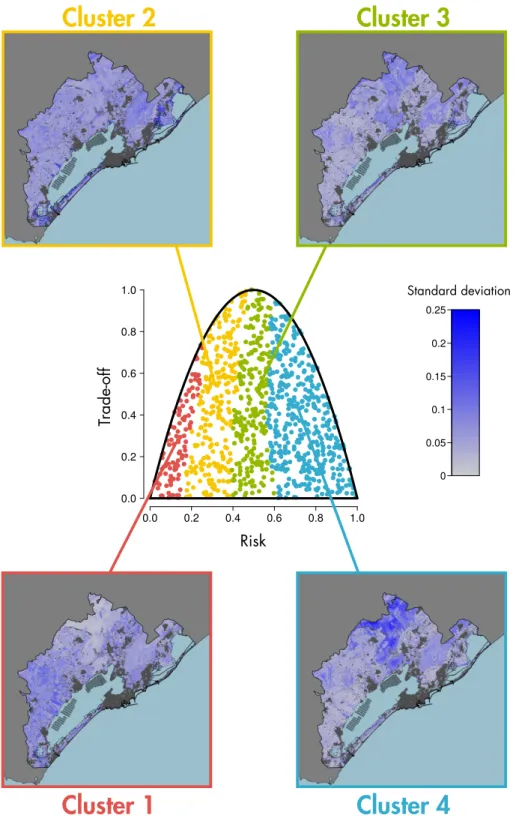
![Table 2 shows the Kendall’s τ coefficient matrix [32]](https://thumb-eu.123doks.com/thumbv2/123doknet/13856994.445199/11.892.468.803.109.345/table-shows-kendall-s-τ-coefficient-matrix.webp)
